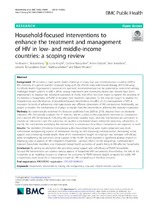| dc.description.abstract | Background: HIV remains a major public health challenge in many low- and middle-income countries (LMICs). The initiation of a greater number of people living with HIV (PLHIV) onto antiretroviral therapy (ART) following the World Health Organization’s ‘universal test and treat’ recommendation has the potential to overstretch already challenged health systems in LMICs. While various mainstream and community-based care models have been implemented to improve the treatment outcomes of PLHIV, little effort has been made to harness the potential of the families or households of PLHIV to enhance their treatment outcomes. To this end, we sought to explore the characteristics and effectiveness of household-focused interventions in LMICs on the management of HIV as measured by levels of adherence, viral suppression and different dimensions of HIV competence. Additionally, we sought to explore the mechanisms of change to explain how the interventions achieved the expected outcomes.
Methods: We systematically reviewed the literature published from 2003 to 2018, obtained from six electronic databases. We thematically analysed the 11 selected articles guided by the population, intervention, comparison and outcome (PICO) framework. Following the generative causality logic, whereby mechanisms are postulated to mediate an intervention and the outcomes, we applied a mechanism-based inferential reasoning, retroduction, to identify the mechanisms underlying the interventions to understand how these interventions are expected to work. Results: The identified HIV-related interventions with a household focus were multi-component and multidimensional, incorporating aspects of information sharing on HIV; improving communication; stimulating social
support and promoting mental health. Most of the interventions sought to empower and stimulate self-efficacy while strengthening the perceived social support of the PLHIV. Studies reported a significant positive impact on improving various aspects of HIV competent household – positive effects on HIV knowledge, communication between household members, and improved mental health outcomes of youths living in HIV-affected households. Conclusion: By aiming to strengthen the perceived social support and self-efficacy of PLHIV, householdfocused HIV interventions can address various aspects of household HIV competency. Nevertheless, the role of the household as an enabling resource to improve the outcomes of PLHIV remains largely untapped by public HIV programmes; more research on improving household HIV competency is therefore required. | en_US |

